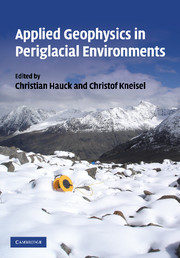Book contents
- Frontmatter
- Contents
- List of contributors
- Introduction
- Part I Geophysical methods
- Part II Case studies
- 5 Typology of vertical electrical soundings for permafrost/ground ice investigation in the forefields of small alpine glaciers
- 6 ERT imaging for frozen ground detection
- 7 Electrical resistivity values of frozen soil from VES and TEM field observations and laboratory experiments
- 8 Results of geophysical surveys on Kasprowy Wierch, the Tatra Mountains, Poland
- 9 Reassessment of DC resistivity in rock glaciers by comparing with P-wave velocity: a case study in the Swiss Alps
- 10 Quantifying the ice content in low-altitude scree slopes using geophysical methods
- 11 The use of GPR in determining talus thickness and talus structure
- 12 GPR soundings of rock glaciers on Svalbard
- 13 Arctic glaciers and ground-penetrating radar. Case study: Stagnation Glacier, Bylot Island, Canada
- 14 Mapping of subglacial topography using GPR for determining subglacial hydraulic conditions
- 15 Snow measurements using GPR: example from Amundsenisen, Svalbard
- 16 Mapping frazil ice conditions in rivers using ground penetrating radar
- Appendix: Tables of geophysical parameters for periglacial environments
- Index
- Plate section
- References
13 - Arctic glaciers and ground-penetrating radar. Case study: Stagnation Glacier, Bylot Island, Canada
Published online by Cambridge University Press: 22 August 2009
- Frontmatter
- Contents
- List of contributors
- Introduction
- Part I Geophysical methods
- Part II Case studies
- 5 Typology of vertical electrical soundings for permafrost/ground ice investigation in the forefields of small alpine glaciers
- 6 ERT imaging for frozen ground detection
- 7 Electrical resistivity values of frozen soil from VES and TEM field observations and laboratory experiments
- 8 Results of geophysical surveys on Kasprowy Wierch, the Tatra Mountains, Poland
- 9 Reassessment of DC resistivity in rock glaciers by comparing with P-wave velocity: a case study in the Swiss Alps
- 10 Quantifying the ice content in low-altitude scree slopes using geophysical methods
- 11 The use of GPR in determining talus thickness and talus structure
- 12 GPR soundings of rock glaciers on Svalbard
- 13 Arctic glaciers and ground-penetrating radar. Case study: Stagnation Glacier, Bylot Island, Canada
- 14 Mapping of subglacial topography using GPR for determining subglacial hydraulic conditions
- 15 Snow measurements using GPR: example from Amundsenisen, Svalbard
- 16 Mapping frazil ice conditions in rivers using ground penetrating radar
- Appendix: Tables of geophysical parameters for periglacial environments
- Index
- Plate section
- References
Summary
Introduction
This case study presents results from multiple ground-penetrating radar (GPR) surveys conducted over a single ablation season at a polythermal glacier in the Canadian Arctic. Recent advances in both equipment functionality and data analysis have allowed researchers to examine notions of spatial variation in subsurface conditions, yet to date the full potential of the geophysical tool has not been exploited. A total of 30 km of radar profile data were collected illustrating how seasonal hydrothermal development can be observed in glaciers, including the appearance and disappearance of hydrological features. However, this research exemplified issues that should be borne in mind when undertaking glacier-based GPR, particularly focusing on resolution, interpolation, increasing noise and short-term temporal variability in glacier ice conditions.
Over the past 50 years, radio-echo sounding (RES) and GPR have been increasingly employed on glaciers to determine a number of geometric and structural conditions. Reflection of a proportion of the impulse wave occurs where there is an abrupt, subsurface transition in dielectric constant (κ). The stark contrast between air (κ = 1), water (κ = 80), sediment (κ ≈ 25) and ice (κ ≈ 3.5) enables the reconstruction of subsurface structures from geophysical surveys. RES was initially focused upon the determination of ice thickness and thus bed topography for ice sheets (e.g. Evans 1963, Robin et al. 1969, Davis et al. 1973, Bentley et al. 1979, Hodge et al. 1990).
- Type
- Chapter
- Information
- Applied Geophysics in Periglacial Environments , pp. 178 - 190Publisher: Cambridge University PressPrint publication year: 2008



